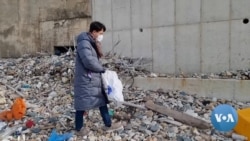ດ້ວຍເຂດຊາຍແດນຂອງເຂົາເຈົ້າໄດ້ປິດ ແລະ ໂດຍລວມແລ້ວຄົນຕ່າງປະເທດທຸກຄົນ ແມ່ນໄດ້ຫາຍໄປ, ເກົາຫຼີເໜືອ ແມ່ນເຂົ້າຫາໄດ້ຍາກກວ່າແຕ່ກ່ອນ ໃນລະຫວ່າງໂຣກລະບາດໄວຣັສໂຄໂຣນາ. ສະນັ້ນ ເພື່ອທີ່ຈະຮູ້ຈັກເສດຖະກິດ ທີ່ໂດດດ່ຽວຂອງປະເທດນັ້ນ, ຜູ້ຕິດຕາມ ເກົາຫຼີເໜືອ ບາງຄົນ ແມ່ນໄດ້ເກັບເອົາສິ່ງເສດເຫຼືອທຸກຢ່າງ ທີ່ເຂົາເຈົ້າສາມາດເກັບໄດ້. ໃນບາງກໍລະນີ, ນັ້ນຈະໝາຍຄວາມວ່າ ໂດຍແທ້ຈິງແລ້ວເຂົາເຈົ້າແມ່ນກຳລັງສຶກສາເບິ່ງຂີ້ເຫຍື້ອຂອງ ເກົາຫຼີ ເໜືອ, ດັ່ງທີ່ນັກຂ່າວວີໂອເອ ບິລ ກາລໂລ ມີລາຍງານຈາກເຂດຊາຍແດນລະ ຫວ່າງປະເທດ ເກົາຫຼີ, ເຊິ່ງ ພຸດທະສອນ ຈະນຳລາຍລະອຽດ ມາສະເໜີທ່ານໃນອັນດັບຕໍ່ໄປ.
ມັນແມ່ນຕອນບ່າຍທີ່ໜາວຂອງເດືອນມັງກອນ, ແລະ ອາຈານ ຄັງ ດອງ-ວອນ ໄດ້ໄປຍ່າງເລາະຢູ່ຫາດຊາຍ ເພື່ອຊອກຫາຂີ້ເຫຍື້ອ.
ໂດຍສະເພາະແລ້ວ, ຂີ້ເຫຍື້ອ ເກົາຫຼີເໜືອ ທີ່ຖືກພັດຂຶ້ນຝັ່ງຢູ່ທີ່ນີ້ ໃນເກາະ ຢອນປຽງ (Yeonpyeong).
ມັນແມ່ນເກາະຫ່າງໄກສອກຫຼີກຂອງ ເກົາຫຼີໃຕ້ ທີ່ຕັ້ງຢູ່ໃກ້ກັບເຂດທະເລທີ່ມີບັນຫາຂັດແຍ້ງກັບ ເກົາຫຼີເໜືອ.
ທ່ານ ຄັງ ແມ່ນຕື່ນເຕັ້ນ. ນີ້ແມ່ນໄອສຄຣີມ ຍີ່ຫໍ້ ເອສກີໂມ ຊະນິດທີ 35 ແຕກຕ່າງກັນ ທີ່ລາວໄດ້ພົບເຫັນ.
ໂດຍລວມແລ້ວ, ລາວເກັບຂີ້ເຫຍື້ອ ເກົາຫຼີເໜືອ ໄດ້ຫຼາຍກວ່າ 1,400 ອັນຕະຫຼອດປີທີ່ຜ່ານມາ.
ທ່ານ ຄັງ ດອງ-ວອນ ອາຈານສອນຢູ່ມະຫາວິທະຍາໄລ ດອງ-ອາ ກ່າວວ່າ “ຂີ້ເຫຍື້ອແມ່ນມີຫຼາກຫຼາຍ, ມີອາຫານ, ເຄື່ອງດື່ມ, ເຂົ້າໜົມ, ຢາ, ເຄື່ອງສຳ ອາງ. ມັນເປັນຄືກັບຕະຫຼາດນ້ອຍ (ເກົາຫຼີເໜືອ) ຢູ່ຫາດຊາຍແຫ່ງນີ້.”
ທ່ານ ຄັງ ເຄີຍໄປຢ້ຽມຢາມ ເກົາຫຼີເໜືອ. ລາວເຄີຍທຳການເດີນທາງຄົ້ນຄວ້າໃນບັນດາເມືອງຕ່າງໆ ຂອງ ຈີນ ໃກ້ກັບເຂດຊາຍແດນຕິດກັບ ເກົາຫຼີເໜືອ. ແຕ່ໃນລະຫວ່າງໂຣກລະບາດ, ນີ້ແມ່ນໃກ້ທີ່ສຸດ ທີ່ລາວສາມາດໄປ.
ແລະ ເກົາຫຼີເໜືອ ແມ່ນຢູ່ໃກ້ຫຼາຍ. ພຽງແຕ່ 4 ກິໂລແມັດຫ່າງອອກໄປເທົ່ານັ້ນ. ມັນສາມາດແນມເຫັນໄດ້ຢ່າງງ່າຍດາຍ ດ້ວຍຕາເປົ່າ, ແມ່ນກະທັ້ງໃນສະພາບອາກາດທີ່ບໍ່ດີ.
“ປາກົດວ່າແທ້ຈິງແລ້ວມັນບໍ່ໄດ້ຍາກທີ່ຈະຊອກຫາຂີ້ເຫຍື້ອ ເກົາຫຼີເໜືອ ຢູ່ຫາດຊາຍ ເກົາຫຼີໃຕ້ ຄືແຫ່ງນີ້, ຖ້າເຈົ້າຮູ້ສິ່ງທີ່ເຈົ້າຊອກຫາ.”
ໃບປິວໂຄສະນາຊວນເຊື່ອອັນນີ້ ໄດ້ກ່າວໂຈມຕີພວກນັກການເມືອງຫົວອະນຸລັກນິຍົມ ເກົາຫຼີໃຕ້.
ຢາງຕ່ອນນີ້ແມ່ນສ່ວນນຶ່ງຂອງກ່ອງຂີ້ເຫຍື້ອຢູ່ໂຮງງານພະລັງງານຄວາມຮ້ອນ.
ແລະ ຄືຫຼາຍຜະລິດຕະພັນ, ຢາງຫໍ່ໝີ່ອັນນີ້ໄດ້ລະບຸຊື່ໂຮງງານຢ່າງຊັດເຈນ ບ່ອນທີ່ມັນຖືກຜະລິດ.
ຮ່ອງຮອຍທີ່ສຳຄັນຕ່າງໆແມ່ນ ກ່ຽວກັບ ສິ່ງທີ່ ເກົາຫຼີເໜືອ ສາມາດນຳເຂົ້າ ແລະ ຜະລິດ, ແລະ ວິທີທີ່ເຂົາເຈົ້າຂາຍຜະລິດຕະພັນ ບາງເທື່ອໃນປະເທດ
ທີ່ເປັນຫົວທຶນນິຍົມໜ້ອຍທີ່ສຸດໃນໂລກ.
ທ່ານ ຄັງ ດອງ-ວອນ ໄດ້ກ່າວວ່າ “ໃນລະຫວ່າງຍຸກສະໄໝຂອງທ່ານ ກິມ ຈົງ ອຶນ, ເກົາຫຼີເໜືອ ໄດ້ໃຊ້ຄວາມພະຍາຍາມຫຼາຍຂຶ້ນ ໃນການອອກແບບຫີບຫໍ່ ແມ່ນກະທັ້ງ ເກົາຫຼີເໜືອ ແມ່ນບໍ່ສາມາດເມີນເສີຍລົດຊະນິຍົມ ແລະ ຄວາມປາຖະໜາຂອງປະຊາຊົນຂອງເຂົາເຈົ້າ.”
ໃນໝູ່ບ້ານທີ່ມິດງຽບຢູ່ໃກ້ຄຽງ, ປະຊາຊົນເວົ້າວ່າ ເຂົາເຈົ້າແທບຈະບໍ່ຮູ້ ກ່ຽວກັບ ຂີ່ເຫຍື້ອ ເກົາຫຼີເໜືອ.
ນາງ ໂອ ກຸຍ-ອິມ ກ່າວວ່າ ລາວໄດ້ເຫັນຫຼາຍກວ່າຂີ້ເຫຍື້ອ ພັດຂຶ້ນເທິງຝັ່ງ.
ນາງ ໂອ ກຸຍ-ອິມ ຜູ້ອາໄສຢູ່ບ້ານ ຢອງປຽງ ກ່າວວ່າ “ລະເບີດຝັງດິນຍັງໄດ້ລອຍໄປມາ, ເຈົ້າຈະບໍ່ຮູ້ວ່າມີສິ່ງຕ່າງໆໄຫຼມາຈາກ ເກົາຫຼີເໜືອ ຫຼາຍປານໃດ. ມີຜະລິດຕະພັນຢ່າງຫຼວງຫຼາຍ ແມ່ນກະທັ້ງສົບຄົນຕາຍ.”
ທ່ານ ຄັງ, ແນວໃດກໍຕາມ, ຍັງຄົງມີຄວາມຫຼົງໄຫຼກັບຂີ້ເຫຍື້ອພຽງເທົ່ານັ້ນ. ລາວຍັງໄດ້ຂຽນປື້ມ ກ່ຽວກັບ ການຄົ້ນພົບຂອງລາວດ້ວຍ.
ທ່ານ ຄັງ ດອງ-ວອນ ກ່າວວ່າ “ດ້ວຍຂີ້ເຫຍື້ອນີ້, ຂ້າພະເຈົ້າສາມາດເຫັນຊີວິດຂອງຊາວ ເກົາຫຼີເໜືອ. ມັນໄດ້ຊ່ອຍໃຫ້ຂ້າພະເຈົ້າເຂົ້າໃຈ ເກົາຫຼີເໜືອ.“
ໂດຍທີ່ ເກົາຫຼີເໜືອ ຍັງຖືກປິດຢ່າງບໍ່ມີກຳນົດ, ຂີ້ເຫຍື້ອຕ່າງໆອາດຈະເປັນທຸກຢ່າງທີ່ລາວມີ ໄປຊົ່ວອີກໄລຍະເວລາໃດນຶ່ງ.
With its borders closed and virtually all foreigners gone, North Korea is more inaccessible than ever during the coronavirus pandemic. So to learn about the reclusive country’s economy, some North Korea watchers are picking up whatever scraps they can. In some cases, that means literally examining North Korean trash, as VOA’s Bill Gallo reports from the inter-Korean border.
It’s a cold January afternoon, and Professor Kang Dong-won is scouring the beach for trash.
Specifically, North Korean trash that has washed ashore here on Yeonpyeong Island.
It’s a remote South Korean island near the disputed sea border with North Korea.
Kang is excited. This is the 35th different type of Eskimo-brand ice cream he's found.
In total, he's collected over 1,400 pieces of North Korean trash over the past year.
“The waste is so diverse — food, beverages, snacks, medicines, cosmetics. It’s like a little [North Korean] market here at the beach.”
Kang has visited North Korea. He used to make research trips to Chinese cities near the North Korean border. But during the pandemic, this is as close as he can get.
And North Korea is incredibly close. Just 4 kilometers away. Easily visible with the naked eye, even in poor weather.
“Turns out it’s not actually that hard to find North Korean trash on South Korean beaches like this, if you know what you’re looking for.”
This propaganda leaflet slams conservative South Korean politicians.
This piece of rubber was part of a trash bin at a thermal power plant.
And like many products, this instant noodle wrapper specifies the exact factory where it was made.
Important clues about what North Korea can import and produce, and how it markets products in perhaps the least capitalist country in the world.
“During the Kim Jong Un era, North Korea has put more effort into package design… not even North Korea can ignore the tastes and desires of its people.”
In the quiet village nearby, residents say they barely notice the North Korean trash.
Oh Gui-im says she’s seen more than just garbage wash ashore.
“Landmines also float around… you have no idea how much stuff comes from the North. So many products — even human corpses.”
Kang, though, remains fascinated by just the trash. He's even written a book on his findings.
“With this trash, I can see the lives of North Koreans. It helps me understand North Korea.”
With North Korea closed indefinitely, scraps may be all that he has for a while.





